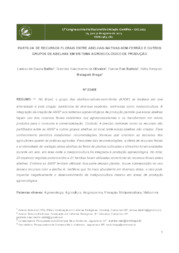Partilha de recursos florais entre abelhas-nativas-sem-ferrão e outros grupos de abelhas em sistema agroecológico.
Partilha de recursos florais entre abelhas-nativas-sem-ferrão e outros grupos de abelhas em sistema agroecológico.
Author(s): BELLINI, L. de S.; OLIVEIRA, G. N. de; BATISTA, E. R.; MALAGODI-BRAGA, K. S.
Summary: Resumo: No Brasil, o grupo das abelhas-nativas-sem-ferrão (ANSF) se destaca por sua diversidade e pela criação zootécnica de diversas espécies, conhecida como meliponicultura. A integração da criação de ANSF aos sistemas agroecológicos de produção permite que essas abelhas façam uso dos recursos florais existentes nos agroecossistemas e os transformem em novos produtos para o consumo e comercialização. Contudo, é preciso conhecer como os recursos são partilhados entre as ANSF e outros grupos abelhas no local onde essas abelhas são criadas. Esse conhecimento permitirá estabelecer recomendações técnicas que orientem as decisões dos agricultores quanto às práticas agrícolas. Para obter tais recomendações, a oferta de recursos florais e a intensidade de visitação pelas abelhas às flores de plantas cultivadas e silvestres foram avaliadas durante um ano, em área onde a meliponicultura foi integrada à produção agroecológica. No total, 29 espécies vegetais pertencentes a 21 famílias foram utilizadas como fonte de recursos florais pelas abelhas. Embora as ANSF tenham utilizado boa parte dessas plantas, houve sobreposição no uso desses recursos com a abelha A. mellifera que foi mais abundante em diversas delas, e isso pode impactar negativamente o desenvolvimento da meliponicultura mesmo em áreas de produção agroecológica. -- Abstract: In Brazil, the group of native stingless bees (ANSF) stands out for its diversity and several species zootechnical rearing, called meliponiculture. The integration of ANSF rearing to the agroecological production systems allows these bees to use floral resources present in the agroecosystems and transform them into new products for both the consumption and the market. However, it is necessary to know how these resources are shared between ANSF and other bee groups in the places where these bees are rearing. This knowledge will allow us to establish technical recommendations which will guide farmers’ decisions regarding agricultural practices. To obtain such recommendations, the supply of floral resources and the intensity of bee visitation to flowers of cultivated and wild plants were evaluated for one year, where meliponiculture was integrated to agroecological production. In total, 29 species of plants belonging to 21 families were used as a source of floral resources by the bees. Although the ANSF used most of these plants, there was an overlap in the use of these resources with the bee A. mellifera, which was more abundant in several of them, and this can negatively impact the development of meliponiculture even in areas of agroecological production.
Publication year: 2023
Types of publication: Paper in annals and proceedings
Unit: Embrapa Environment
Observation
Some of Embrapa's publications are published as ePub files. To read them, use or download one of the following free software options to your computer or mobile device. Android: Google Play Books; IOS: iBooks; Windows and Linux: Calibre.
Access other publications
Access the Agricultural Research Database (BDPA) to consult Embrapa's full library collection and records.
Visit Embrapa Bookstore to purchase books and other publications sold by Embrapa.

